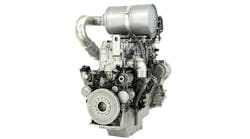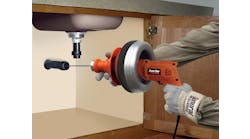A Rental Center's Best Friend Most rental centers carry abrasive and diamond blades. The biggest reason is customer convenience. Although the sale of such accessories can be profitable, in this age of one-stop shopping, when contractors are always in a hurry, if you provide the saws but not the blades, they might be tempted to go to a rental center that carries both.
When a rental counter person is called upon to select a diamond blade for a customer, he or she must begin by finding out what type of sawing machine the blade will be used on and the blade thickness the machine can accommodate. Then the counter person should find out what kind of material will be cut and if the customer is doing wet or dry cutting.
Before addressing those questions, a bit of background on diamond blades might be helpful. A diamond blade is a circular steel disc with a diamond-bearing edge. The edge or rim can have a segmented, continuous or serrated configuration. The blade core is a precision-made steel disc that might have slots called gullets, which provide faster cooling by allowing water or air to flow between the segments.
Blade cores are tensioned so the blade will run straight at the proper cutting speed but remain flexible enough to bend slightly under cutting pressure.
Diamond segments are made up of a mixture of diamonds and metal powders. The metal bond that holds the diamond particles in place is made up of a composition of cobalt, steel and bronze. The composition of this bond must be matched to the hardness or softness of the material being cut. Soft, abrasive materials, which tend to have large particles, wear down this metal bond faster than the small particles from hard, dense materials.
As a result, the diamond blade for cutting soft, abrasive material must have a hard bond to resist the rapid wear long enough for the diamonds to be fully used.
The hard-soft rule If a blade is to be used for cutting hard, nonabrasive material, it must have a soft bond to ensure that it will wear and expose new diamonds to keep the blade cutting efficiently. The composition of the bond that holds the diamond particles must be matched to the hardness or softness of the material being cut. One simple guideline might help rental center personnel who could forget more technical details. It might even be something you can post on the wall: "Use something hard to cut something soft. Use something soft to cut something hard."
In reality, diamond blades grind rather than cut. The exposed diamond crystals do the grinding while the bond holds the diamonds in place. Behind each diamond is a bond tail that helps support the diamond. As the blade rotates through the material, the exposed surface diamonds grind the surface into a fine powder. After several thousand passes through the material, the exposed diamonds begin to crack. The bond also begins to wear away. Eventually the diamond completely breaks up, and its fragments are swept away with the material that it is grinding. As the old diamonds are worn down, they are replaced by new ones, and the process continues until the blade is worn out.
Remember also that larger aggregates tend to make a blade run slower. Smaller aggregates tend to make it run faster.
You also need to know something about the saw. Is it a wet or dry saw, a walk-behind or hand-held model? How thick a blade can the machine handle?
Blades for higher-horsepower saws might require harder bonds and higher diamond concentration. Blades for lower-horsepower saws might need softer bonds and lower diamond concentrations. Increasing spindle speed makes the diamond blade cut harder. Decreasing spindle speed makes the blade cut faster. Harder, less abrasive materials require slower spindle speeds, while softer, more abrasive materials require faster spindle speeds.
No matter what the application, never operate blades at rotational speeds greater than the maximum rpm because that can cause blade damage and potential injury. The recommended rpm is stamped on the blade. When in doubt, consult your diamond blade manufacturer.
Also remember, when purchasing diamond blades, price should not be the only selection criterion. The higher the blade segment and greater the diamond concentration, the more the blade likely will cost. But higher segments and greater diamond concentration also will make it cut faster and last longer.
Marketing and merchandising A bit of effort and creativity can help you increase your diamond tool and equipment rentals and sales. Use the wall behind the counter to display diamond blades. Hang segmented blades for high-speed saws or masonry saws. Show continuous-rim blades for tile applications and wet segmented blades for cured concrete, asphalt or green concrete. Put a high-speed blade on a cutoff saw, and display the combination on an eight-block. Label your displays by application so the customer is aware there are different blades for different applications.
Your diamond blades and tools are valuable products to your customers. A bit of merchandising might reveal their potential and profit.
Norton
The Contender line of diamond blades from Norton cuts ceramic tile, granite, marble, slate and paving bricks, the company says. The wet- and dry-cutting tile blades are offered in 4- to 10-inch sizes with 12- and 14-inch high-speed blades also available. www.nortonabrasives.com
Partner
Partner Industrial Products, a manufacturer of cutoff saws, also offers a line of PowerCut diamond blades for dry and wet cutting. The company says it uses only synthetic diamonds because they are harder and more consistent than natural diamonds. The blades feature laser-cut cores individually tensioned to run at proper operating speeds and minimize wear. www.partnerusa.com
Target
The TCO abrasive blade is designed for dry cutting on a right-angle grinder. The generalpurpose blade is available as a Type 1 or, for flush cutting, a Type 27 raised hub. The TCO Fast Cut, designed for fast cutting of metal, stainless steel and alloys, has a profile of .045 inches. The TCO Long Life also cuts metal, stainless steel and alloys but has a profile of .094 inches. 800/288-5040
Makita
The zirconium Multi-Discs provide consistent high cut rates with cooler temperatures, according to Makita. As the abrasive cloth flaps wear away, new and sharp grains are exposed. Applications include weld head blending, deburring and edge blending, metal fabrication, weld slag removal and surface conditioning. www.makitatools.com
Star Diamond Tools
The Wonder blade is a combination/utility dry diamond blade that can cut concrete, asphalt and masonry materials when used with high-speed concrete and masonry saws. Star Diamond says it can do the job of six blades. www.stardiamondtools.com
DML
Golden Eagle saw blades from DML, a division of Primark Tool Group, are available in diameters from 2 inches to 30 inches and have tips of C-4 Dyanite carbide, the company's carbide formulation. According to the manufacturer, Dyanite carbide tips start sharper, stay sharp two to five times longer and can be resharpened. The blade's industrial plate is made of heat-treated tool steel. www.primarktoolgroup.com
Hitachi
The Hardiblade is a polycrystalline diamond-tipped blade manufactured using microwave heating to harden and bond a surface layer of powdered diamond to the tungsten carbide teeth. According to Hitachi, this increases the blade's cutting endurance, and the four-tooth configuration allows for fast, low-dust cutting. www.hitachi.com
Pearl Abrasive
The AB Series of segmented diamond blades is constructed of an ultra-hard diamond matrix and specialized GE diamonds to maximize performance when cutting abrasive materials such as brick, block and green concrete, according to Pearl. Alternating the diamond segments with deep and semi-deep lengths is designed to protect the core against excessive wear, prevent undercut and improve swarf removal. The wear-resistant core extends blade life by dissipating heat, the company says. 800/969-5561 (U.S.) 800/387-0008 (Canada)
Abmast
The new Supra grinding wheels use superior abrasive grains and the latest design technology, according to Abmast. The wheels produce more stock removal and less dust discharge. www.abmast.com
Multiquip
Multiquip's line of diamond blades can be used when working with asphalt and cured or green concrete. The line features cured-concrete blades, green-concrete blades, asphalt blades, Series 2 blades, premium Series 3 blades and super-premium Series 4 blades. Each blade features a specific composition and design for its application. www.multiquip.com
Diamond Products
Diamond Products offers two illustrated brochures containing detailed information about the company's product lines for cutting. The 56-page Core Cut Saw Catalog features concrete saws, masonry saws, wall saws, specialty saws and sawing accessories. The 20-page Stone Cutting Products brochure features stonecutting blades, tools, bits, saws, rigs and accessories. 800/321-5336
MK Diamond
MK Diamond offers a full line of diamond blades including continuous-rim wet blades, serrated-edge dry blades and segmented-edge dry blades. According to the company, the continuous-rim wet blades provide fast, chip-free cutting of tile and other vitreous material; serrated-edge dry blades cut with minimal chipping of masonry material; and segmented-edge dry blades provide maximum life and durability for cutting various types of masonry. www.mkdiamond.com





